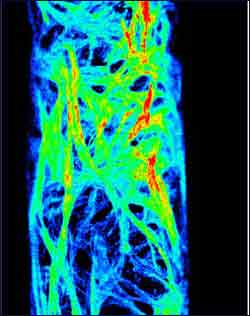Scientists Make Breakthrough In Understanding Muscle Contraction

Muscle bundles within the ureter showing different levels of calcium. The red colour shows the highest level of calcium, followed by green and blue
New research into muscle contraction will give scientists a better understanding of bladder problems and pain during childbirth.
Professor Susan Wray, who heads the UK’s top rated Department of Physiology, and Dr Ted Burdyga, are studying muscles in the wall of the ureter, which connects the kidney to the bladder, to understand how muscles respond to signals in the body telling them to contract or relax. Their research, supported by the Medical Research Council, is published in this week’s issue of Nature.
Muscles contract and relax to allow the body to perform crucial activity. Electrical signals tell the muscle when to contract, but when the muscle needs to relax, the signal is deliberately ignored. Until now scientists have been unable to understand how the body ignores this signal.
The team found that calcium, which allows muscle contraction to take place, enters the body’s cells in response to electrical signals. The calcium fills up a small structure in the cell and when this is full and starts to empty, it forces the muscle to relax by preventing any more calcium entering the cell, even when it receives contraction signals.
Professor Wray explains: “Electrical signals in nerves and muscles are important for all activity, from thinking to drinking. It is important for the body to be active, but it is also important for it to relax, so that it doesn’t over work itself. For example, in childbirth the uterus contracts and relaxes at regular intervals to allow a baby to pass through the birth canal.
“But when we get cramps for example, our muscle is contracting too hard or too often and in the case of the ureter it would cause kidney damage. It is therefore crucial that our muscles have periods of relaxation and we have now uncovered how this occurs. This understanding should allow doctors to work more accurately with the body’s natural mechanisms when treating patients.”
Media Contact
More Information:
http://www.liv.ac.ukAll latest news from the category: Health and Medicine
This subject area encompasses research and studies in the field of human medicine.
Among the wide-ranging list of topics covered here are anesthesiology, anatomy, surgery, human genetics, hygiene and environmental medicine, internal medicine, neurology, pharmacology, physiology, urology and dental medicine.
Newest articles

Security vulnerability in browser interface
… allows computer access via graphics card. Researchers at Graz University of Technology were successful with three different side-channel attacks on graphics cards via the WebGPU browser interface. The attacks…

A closer look at mechanochemistry
Ferdi Schüth and his team at the Max Planck Institut für Kohlenforschung in Mülheim/Germany have been studying the phenomena of mechanochemistry for several years. But what actually happens at the…

Severe Vulnerabilities Discovered in Software to Protect Internet Routing
A research team from the National Research Center for Applied Cybersecurity ATHENE led by Prof. Dr. Haya Schulmann has uncovered 18 vulnerabilities in crucial software components of Resource Public Key…





















